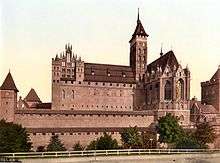Treaty of Marienburg
The treaty of Marienburg, concluded on 29 June 1656, was a Brandenburg-Prussian – Swedish alliance during the Second Northern War.[1]
 | |
| Type | offensive alliance |
|---|---|
| Signed | 29 June 1656 |
| Location | Marienburg (Malbork) castle |
| Signatories | Charles X Gustav of Sweden Frederick William I of Brandenburg |
| Parties | Swedish Empire House of Hohenzollern |
| Language | Latin |
In January 1656, Charles X Gustav of Sweden had made Frederick William I, Elector of Brandenburg, his vassal for the Duchy of Prussia.[2] By the time of the treaty of Marienburg, Swedish prospect in the war had diminished, and Charles X Gustav was willing to offer Frederick William I a reward for fighting on his side.[1] While the latter was to remain a Swedish vassal for Prussia, he was promised hereditary sovereignty in four voivodeships[3] of Greater Poland in return for participating in the Charles X Gustav's Polish campaigns.[1] This alliance proved victorious in the subsequent Battle of Warsaw, but as further campaigns stalled, Frederick William I was to gain full sovereignty in Prussia by the Treaty of Labiau in November 1656.[4]
Sources
References
- Frost (2000), p. 173
- Frost (2000), p. 171
- Erdmannsdörfer (ADB), p. 485
- Frost (2000), p. 178
Bibliography
- Erdmannsdörffer, Bernhard: Friedrich Wilhelm (Kurfürst von Brandenburg), in: Allgemeine Deutsche Biographie, published by Historische Kommission bei der Bayerischen Akademie der Wissenschaften, Band 7 (1878), pp. 480–497, fulltext at de.wikisource
- Frost, Robert I (2000). The Northern Wars. War, State and Society in Northeastern Europe 1558-1721. Harlow: Longman. ISBN 978-0-582-06429-4.